

Brought by NotebookLM
Marketing to transfer students is a unique challenge that requires a tailored approach. Transfer students often have different priorities and concerns than traditional first-year students. They’re usually more focused on credit transfer policies, financial aid, and how quickly they can complete their degrees.
As higher education marketers, understanding these priorities and effectively communicating your institution's strengths can make all the difference in attracting and retaining transfer students.
Marketing to transfer students requires a different approach than marketing to traditional first-year students. According to Inside Higher Ed, more than a third of all college students move from one college to another at least once in their academic careers.
Not to mention transfer students are often older, more experienced, and have different priorities, such as graduating as quickly as possible and minimizing costs. They also have more complex academic histories, which means they need clear, detailed information about how their credits will transfer and how they can achieve their academic goals at your institution.
Understanding these differences and tailoring your marketing strategies accordingly can help your institution attract and retain more transfer students, ultimately leading to higher enrollment numbers and a more diverse student body.
One of the most effective ways to market to transfer students is by creating dedicated landing pages that address their specific needs. These pages should provide clear information on credit transfer policies, articulation agreements with community colleges, financial aid options, and degree completion timelines.
Consider including a credit transfer calculator on these pages, allowing prospective transfer students to easily see how their existing credits will apply to your institution’s programs. This feature can significantly reduce uncertainty and build trust, encouraging more students to consider transferring to your institution.
Tip: Use testimonials from successful transfer students who have navigated the credit transfer process at your institution. This not only provides social proof but also helps to build a sense of community among prospective students.
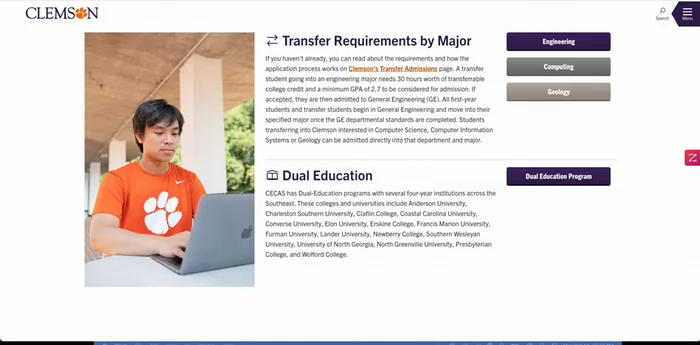
(Image Source: Clemson University)
Transfer enrollment now accounts for 13.2% of all continuing and returning undergraduates, an increase from 12.5% last year and 12.3% in fall 2021. Making the process feel smooth for this growing population can pay off in dividends.
Ensure that your online application portal is user-friendly and clearly outlines the required documents and steps. Offering a dedicated admissions counselor who specializes in transfer students can also provide personalized support, helping to answer any questions and guide students through the process.
Financial aid is a critical concern for transfer students, many of whom may be balancing school with work or family responsibilities. Make sure your marketing materials prominently feature information about available scholarships, grants, and other financial aid options specifically for transfer students.
Consider creating targeted email campaigns that outline these opportunities, as well as any deadlines or special considerations. Personalized communication can make a big difference in reassuring students that your institution is affordable and supportive of their financial needs.
Tip: Include a section on your website dedicated to financial aid for transfer students, with clear steps on how to apply and what to expect during the process.
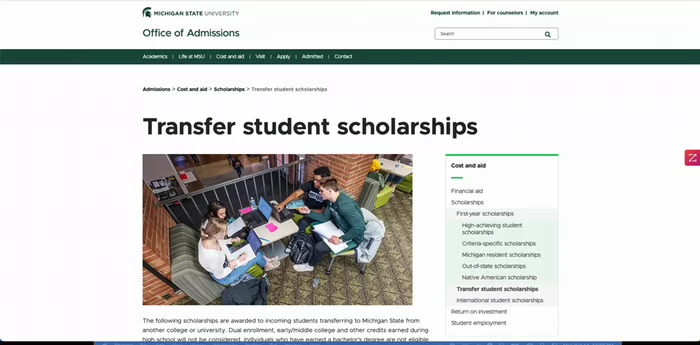
(Image Source: Michigan State University)
Transfer students are often looking for a fresh start or the opportunity to advance their careers by completing their degrees. Use your marketing channels to showcase the unique benefits of transferring to your institution, such as smaller class sizes, access to specialized programs, or opportunities for internships and job placements.
Consider featuring success stories from alumni who transferred and went on to achieve their career goals. This not only inspires but also highlights the real-world value of choosing your institution.
Tip: Use video testimonials or social media posts from current transfer students who can speak to the positive experiences they’ve had since making the switch.
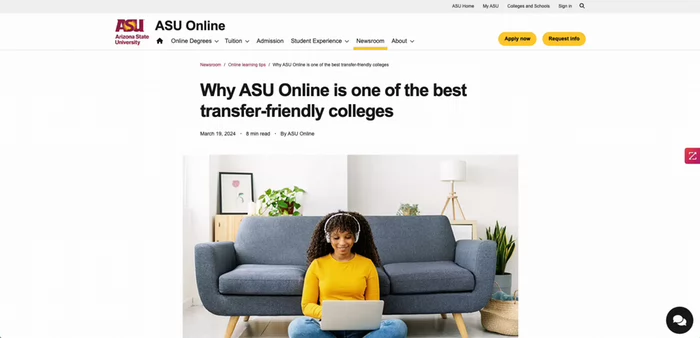
“While 80% of community college students intend to transfer, fewer than 20% make it to a four-year institution and complete a bachelor’s degree,” shares Joe Garcia, Chancellor of the Colorado Community College System.
He goes on to say:
“It’s imperative that higher education works together to help these students who are disproportionately first-generation, low-income, working parents, and students of color—complete the transfer process, graduate, and enter the workforce.”
Many transfer students come from community colleges, so building strong partnerships with these institutions can be a key recruitment strategy. Work closely with community college advisors to ensure they have up-to-date information about your transfer policies, programs, and scholarships.
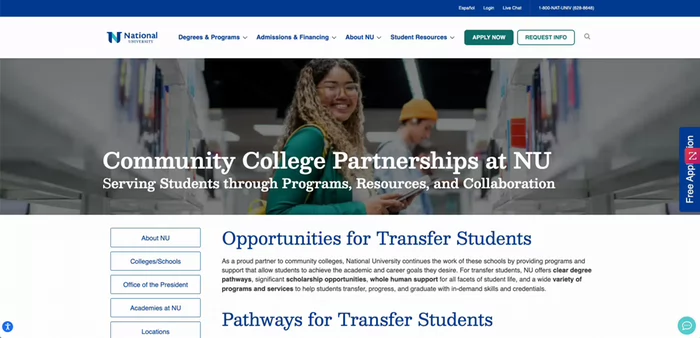
(Image Source: National University)
Web personalization is crucial when marketing to transfer students. Use data-driven insights to tailor your messaging based on where students are in the transfer process. For example, students who have already started their applications may need reminders about upcoming deadlines, while those who are just beginning to explore their options might benefit from general information about your institution.
Consider using personalized email campaigns, targeted social media ads, and even direct mail to reach prospective transfer students. The more you can make them feel like your institution understands and values their unique needs, the more likely they are to choose your school.
Tip: Segment your audience by factors like location, previous institution, and intended major to deliver highly relevant content that resonates with each group of transfer students.
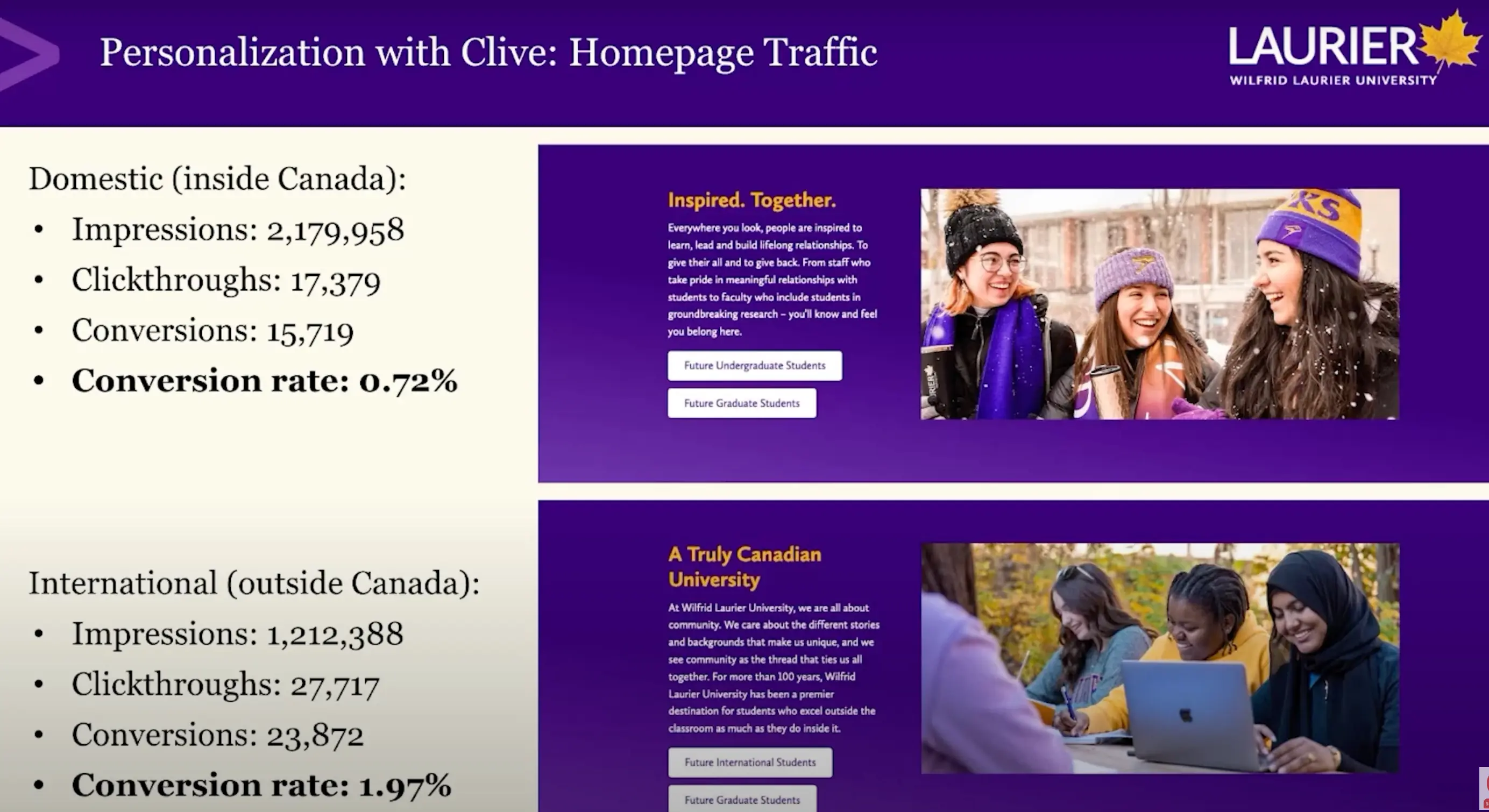
(Image Source: Wilfrid Laurier University Spotlight)
Transfer students often have specific concerns, such as how long it will take to graduate, whether they will fit in with the campus community, and how their previous credits will transfer. A study by the Government Accountability Office (GAO) found that an average of 43% of credits are lost during the transfer process, which is a major concern for transfer students.
Address these concerns head-on in your marketing materials.
Create FAQ sections on your website, host webinars or virtual Q&A sessions, and provide detailed guides that walk students through the entire transfer process. Being transparent and proactive in addressing these issues can build trust and reduce anxiety for prospective transfer students.
Tip: Offer one-on-one consultations with admissions counselors or current transfer students to provide personalized support and answer specific questions.
Personalization is key when it comes to marketing to transfer students, and our web personalization tool, can significantly boost your efforts.
Web personalization enables you to deliver tailored messages across your website, ensuring that transfer students receive the information they need, exactly when they need it. By addressing their unique concerns and providing relevant content at just the right moment, you can create a more engaging and supportive experience for prospective transfer students.
Here’s how Clive can make a difference:
By leveraging Clive, you can provide transfer students with a seamless, supportive experience that addresses their concerns and encourages them to take the next step in their educational journey. This level of personalized communication helps build trust, making it easier for transfer students to see themselves thriving at your institution.
Marketing to transfer students is all about understanding their unique needs and providing clear, personalized communication that addresses their concerns. By implementing these strategies, higher education marketers can create a more welcoming and supportive environment for transfer students, helping them to succeed and thrive at your institution.
To learn more about how Clive can help you tailor your content, request a discovery call by filling out the form below.
Last Updated: Oct 17, 2024 11:00 AM